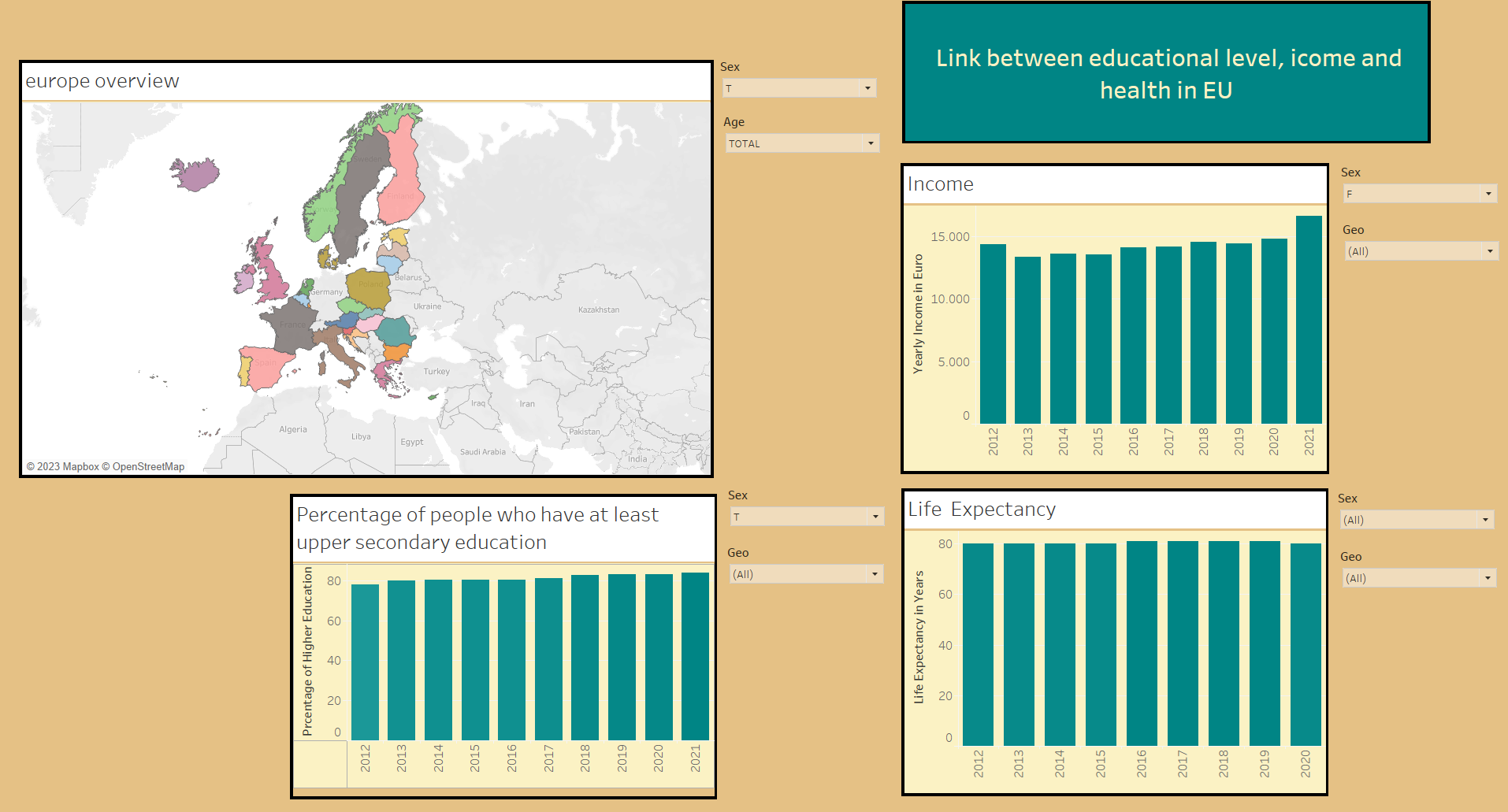Link between educational level, income and health in EU
Link between educational level, income and health in EU.
In this project I am using the European Union data base in Database - Eurostat (europa.eu) to identify the possible relationships between income, life expectancy and educational level in the EU area.
The question
The questions I will try to answer are the following:
1. Is high education connected with high income?
2. Is high income connected with a longer life expectancy?
3. Are there differences in income, education and life expectancy between the genders?
4. Are the above conclusions applicable in the Netherlands?

Cleaning
After downloading the datasets, I cleaned them. The cleaning of the data refers to removing any necessary data, duplicates and errors, addressing any missing values and overall making the data clear and readable to analyse later.
These are the steps I followed to clean the data:
* I selected and imported custom income table from Database - Eurostat (europa.eu) as scv file
* Replaced “ “ with “,” so that can be read as a spreadsheet
* Loaded the scv file in excel
* Filtered numeric values with letters and deleted the letters
* Deleted columns A and Q
* Trimmed the entire table using =TRIM()
* The amounts were values were strings instead of numbers and the =VALUE() function didn’t work because there was a tab space in each number cell. The “find and replace” could not find the tab space , so I had to do it manually.
* Deleted the column “indic_il” and “unit” and turned the numeric values into euro
* I selected and imported custom tables at_least_upper_secondary_education and life_expectancy from Database - Eurostat (europa.eu) as xlsx files
* Replaced “:” with “ “
* Deleted values with letters
* Added a column for sex
* Separated genders on different sheets

Analysis
Analysing the data means to transform them in order to answer the questions. I will try to answer the goal questions one by one.
1. Is high education connected with high income?
To answer this question , I will use the income table for both genders and the education table for both genders. Then compare the results with tables on genders separately.
The country names in income_total and education_total were not compatible. I had to change them.
First I created a dashboard on Tableau that shows the income per year, age and sex in each European country separately.
Then I created this dashboard that shows the relationship between income and high education.
If we set the filters Geo to “EU” for income and “All” for education Sex = “T “(total), we can see that higher education percentage has risen from 78% to 84% since 2012 and median income has risen from 15.216€ to 18.689€. From that we see that there is indeed a correlation between high education and higher income. Although, if we set the Geo filter to include all countries without the “EU” and “EU28” options, the income drops at 2012-2013 ang goes up again at 2020-2021. This is expected due to the late effects in Europe of the US economic recession in 2008 and the Covid – 19 pandemic in 2019. Overall people continued to educate themselves and this seems to have an impact on median income.
2. Is high income connected with a longer life expectancy?
To answer this question I created this dashboard that shows the relationship between income and life expectancy.
As we previously said, the median income in EU has risen since 2012 from 15.216€ to 18.689€. However the life expectancy has not changed much (from 80 to 81 years). Of course, we are only seeing a small window in history that income maybe was not able to reflect on life expectancy. For that, further analysis is suggested.
For now, we do not notice any correlation between the two variables.
3. Are there differences in income, education and life expectancy between the genders?
Both genders increased their income during 2012 – 2021 (a median of 15.517€ to 19.030€ for males and 14.924€ to 18.364€ for females) but there is a small gap between the genders (593€ in 2012 to 666€ in 2021). This could be due to other factors such as the types of contacts, hours worked etc. . For that, further analysis is suggested.
The difference in education for the two genders seems to be higher in 2012 (80% for males and 77,5% for females)compared to 2021 (84,5% for males and 84% for females)
Females seem to have a longer life expectancy than men (78-80 years for men, 83-84 years for women)
4. Are the above conclusions applicable in the Netherlands?
Income
The total median income has increased (from 21.095€ to 29.411€)
The median income for females has increased (from 20.553€ to 28.887€)
The median income for males has increased (form 21.632€ to 29.587€)
There is a pay gap between the two genders but this has decreased (1.079€ to 700€)
Education
The Percentage of people who have at least upper secondary education has increased (from 73% to 81%)
The Percentage of females who have at least upper secondary education has increased (from 72% to 81%)
The Percentage of males who have at least upper secondary education has increased (from 75% to 80%)
Life expectancy
The total life expectancy has changed from 81 to 82 years
The life expectancy for males has changed from 79 to 80 years
The life expectancy for females has not changed (83 years)

Conclusions
1. There is a correlation between income and high education but not between income and life expectancy.
2. Males are getting paid more than females but both genders income has increased.
3. High education percentage has increased for both genders. In 2021, the percentage for both genders is approximately the same.
4. Females have a longer life expectancy than males.
5. The above conclusions are applicable to the Netherlands too.